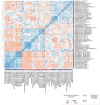Distinct Changes Occur in the Human Breast Milk Microbiome Between Early and Established Lactation in Breastfeeding Guatemalan Mothers
- PMID: 33643228
- PMCID: PMC7907006
- DOI: 10.3389/fmicb.2021.557180
Distinct Changes Occur in the Human Breast Milk Microbiome Between Early and Established Lactation in Breastfeeding Guatemalan Mothers
Abstract
Human breast milk contains a diverse community of bacteria, but as breast milk microbiome studies have largely focused on mothers from high income countries where few women breastfeed to 6 months, the temporal changes in the breast milk microbiome that occur during later lactation stages have not been explored. For this cross-sectional study, microbiota from breast milk samples of Mam-Mayan mothers living in eight remote rural communities in the Western Highlands of Guatemala were analyzed. All mothers delivered vaginally and breastfed their infants for 6 months. Breast milk from 76 unrelated mothers was used to compare two lactation stages, either "early" (6-46 days post-partum, n = 33) or "late" (109-184 days post-partum, n = 43). Breast milk microbial communities were assessed using 16S ribosomal RNA gene sequencing and lactation stages were compared using DESeq2 differential abundance analysis. A total of 1,505 OTUs were identified, including 287 which could be annotated as putative species. Among several maternal factors, lactation stage explained microbiome variance and inertia in ordination with the most significance (p < 0.001). Differential abundance analysis identified 137 OTUs as significantly higher in either early or late lactation. These included a general shift from Staphylococcus and Streptococcus species in early lactation to Sphingobium and Pseudomonas species in late lactation. Species enriched in early lactation included putative commensal bacteria known to colonize the infant oral and intestinal tracts whereas species enriched in late lactation had a uniform functional trait associated with aromatic compound degradation. Differentially abundant species also included several species which have not previously been reported within breast milk, such as Janthinobacterium agaricidamnosum, Novosphingobium clariflavum, Ottowia beijingensis, and Flavobacterium cucumis. These discoveries describe temporal changes to the breast milk microbiome of healthy Guatemalan mothers from early to late lactation. Collectively, these findings illustrate how studying under-represented human populations might advance our understanding of factors that modulate the human milk microbiome in low and middle income countries (LMIC).
Keywords: 16S rRNA gene; human breast milk; lactation stage; metagenomics 16S; microbiome.
Copyright © 2021 Gonzalez, Brereton, Li, Lopez Leyva, Solomons, Agellon, Scott and Koski.
Conflict of interest statement
The authors declare that the research was conducted in the absence of any commercial or financial relationships that could be construed as a potential conflict of interest.
Figures



Similar articles
-
Human milk microbial species are associated with infant head-circumference during early and late lactation in Guatemalan mother-infant dyads.Front Microbiol. 2022 Nov 16;13:908845. doi: 10.3389/fmicb.2022.908845. eCollection 2022. Front Microbiol. 2022. PMID: 36466698 Free PMC article.
-
Human milk microbiome is shaped by breastfeeding practices.Front Microbiol. 2022 Sep 8;13:885588. doi: 10.3389/fmicb.2022.885588. eCollection 2022. Front Microbiol. 2022. PMID: 36160202 Free PMC article.
-
Human milk microbiome: associations with maternal diet and infant growth.Front Nutr. 2024 Mar 11;11:1341777. doi: 10.3389/fnut.2024.1341777. eCollection 2024. Front Nutr. 2024. PMID: 38529196 Free PMC article.
-
Calcium intakes and bone densities of lactating women and breast-fed infants in The Gambia.Adv Exp Med Biol. 1994;352:243-55. doi: 10.1007/978-1-4899-2575-6_22. Adv Exp Med Biol. 1994. PMID: 7832054 Review.
-
Using Community Ecology Theory and Computational Microbiome Methods To Study Human Milk as a Biological System.mSystems. 2022 Feb 22;7(1):e0113221. doi: 10.1128/msystems.01132-21. Epub 2022 Feb 1. mSystems. 2022. PMID: 35103486 Free PMC article. Review.
Cited by
-
Human milk microbial species are associated with infant head-circumference during early and late lactation in Guatemalan mother-infant dyads.Front Microbiol. 2022 Nov 16;13:908845. doi: 10.3389/fmicb.2022.908845. eCollection 2022. Front Microbiol. 2022. PMID: 36466698 Free PMC article.
-
Mismatches in 16S rRNA Gene Primers: An Area Worth Further Exploring.Front Microbiol. 2022 Jun 13;13:888803. doi: 10.3389/fmicb.2022.888803. eCollection 2022. Front Microbiol. 2022. PMID: 35770162 Free PMC article. No abstract available.
-
Human Milk from Tandem Feeding Dyads Does Not Differ in Metabolite and Metataxonomic Features When Compared to Single Nursling Dyads under Six Months of Age.Metabolites. 2022 Nov 4;12(11):1069. doi: 10.3390/metabo12111069. Metabolites. 2022. PMID: 36355152 Free PMC article.
-
Current knowledge on the effects of environmental contaminants in early life nutrition.Front Nutr. 2023 Jun 1;10:1120293. doi: 10.3389/fnut.2023.1120293. eCollection 2023. Front Nutr. 2023. PMID: 37324741 Free PMC article. Review.
-
The Microbiome: From the Beginning to the End.Mo Med. 2024 Jul-Aug;121(4):310-316. Mo Med. 2024. PMID: 39575080 Free PMC article.
References
-
- Arulazhagan P., Al-Shekri K., Huda Q., Godon J.-J., Basahi J. M., Jeyakumar D. (2017). Biodegradation of polycyclic aromatic hydrocarbons by an acidophilic Stenotrophomonas maltophilia strain AJH1 isolated from a mineral mining site in Saudi Arabia. Extremophiles 21 163–174. 10.1007/s00792-016-0892-0 - DOI - PubMed
LinkOut - more resources
Full Text Sources
Other Literature Sources
Molecular Biology Databases

